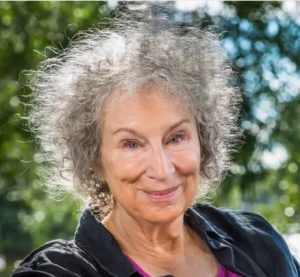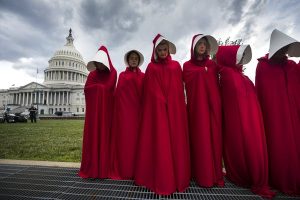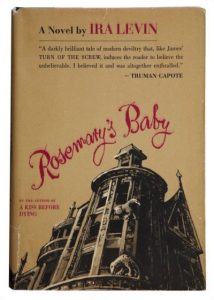The Pregnancy Test is very excited to host our second guest blog post, this time from none other than the doyenne of literary Maternal Studies, Parley Ann Boswell! Read one for her fascinating review of Margaret Atwood’s The Testaments. (Those of you with subscriber access to the London Review of Books may be interested to compare Deborah Friedell’s opinion of the same book as ‘one long caper’).

Margaret Atwood announced in 2018 that she was writing a sequel to her 1985 novel The Handmaid’s Tale. By then, the original novel had moved from our bookshelves and onto our screens, where Hulu had streamed new life into Atwood’s speculative story. Since then, we have been able to watch two more full seasons of The Handmaid’s Tale in which the characters in Gilead are projected through further struggles, and we anticipate another season in 2020. Some of us might have worried. How might another Handmaid novel by Atwood coexist in a world full of Handmaid adaptations, Halloween costumes, political references, and internet chatter? Was there room in all of this for another novel? Those of us who have loved this novel since 1985 might feel proprietary enough to have other worries. Sequels—whether in print or on screen—are often disappointments. Would Atwood’s sequel be a disappointment? Would she be able to sustain the world of Gilead? Or would we feel let down?
Oh, who asks such silly questions?! O ye of little faith, you readers who cannot trust the magic of Margaret Atwood’s storytelling! Atwood’s novel The Testaments confirms, as ever, that she remains one of the great masters of storytelling in English. The Testaments continues the harrowing story of a dystopian Gilead in which women’s bodies, and their capacities to grow babies inside their bodies, have become ground zero in the former United States of America. Women, from Commanders’ wives to little girls, seem powerless in the Republic of Gilead, and their lives have become a battleground. In The Testaments, once again we learn about this struggle not from the men who have created Godly Gilead, but from the battleground itself: the women. Living as trophies, slaves and broodmares, the subdued female characters find subversive ways to speak truth to power.

In The Testaments, fifteen years have passed since our Handmaid Offred ended her tale by stepping “up, into the darkness within; or else the light,” and we hear a trinity of female narrators whose stories eventually braid together (Tale 295). None of these voices is Offred’s. Two voices are those of girls: one living in Canada (Daisy/Nicole) and one in Gilead (Agnes Jemima), both of whose stories begin to make sense after we do some simple arithmetic and figure out that they just might be related to our Offred. The third storyteller, Aunt Lydia, we already know, if only superficially, from The Handmaid’s Tale. In The Testaments, she introduces Gilead to us and fills in some context for us, including flashbacks about how she became the most powerful Aunt in Gilead and about her relationship with the Commanders.
Aunt Lydia’s narration brackets The Testaments. She functions as the chorus in this tale of Gilead, suggesting the moral parameters that women face when they live in a world in which their bodies have defined them as tools, commodities, and sometimes collaborators. Lydia explains her relationship with her superior, Commander Judd. “I believe he enjoys our little tête-à-têtes, for reasons that are complex and perverse. He thinks of me as his handiwork: I am the embodiment of his will” (Testaments 137). If Lydia has convinced Judd that her body represents his will—which she proves to him with ruthless steeliness—then she has figured out how to subvert his power. She uses Judd’s blind vanity, greed, and (in a remarkable reflection of our own time) his penchant for pubescent virgins, in a long game she is playing throughout the novel. But she knows that she’s playing for real.
Our other, younger narrators: Daisy/Nicole of Toronto, Canada, and Agnes Jemima of Gilead, learn gradually how they fit into this ghastly Gileadean world. As they begin to understand their relationships to Gilead and to each other, their stories reveal their transformation from provincial teenaged girls who take their lives for granted, into courageous young women whose own losses and vulnerabilities mature them into warriors. Eventually, Nicole and Agnes function together as the lynchpin of Aunt Lydia’s grand plan to take down the Commanders and Gilead. They both have individual talents to help them. Throughout the novel, they show flashes of wry humor and they both have sharp observational skills. They learn to use these skills, and not coincidentally, their bodies, to their advantage. And, also not coincidentally, they both behave in ways that we might recognize from The Handmaid’s Tale. They remind us of another vulnerable yet shrewd young woman we have met in Gilead, one without her own name: Offred.
In interviews, Atwood has noted that she did not want to try to reproduce Offred’s voice again in The Testaments, and although we do hear and see her briefly near the end of the novel, she is not a major character. Beyond her own tale, most of what we know about Offred we learn from the “Twelfth-and Thirteenth Symposiums on Gileadean Studies,” Atwood’s clever recreations of academic conferences, which serve as the codas for both novels. Centuries have passed, and Gilead remains a curiosity and a scholarly discipline for historians, “Gilead Studies.” From the 12th Symposium that closes The Handmaid’s Tale we learn that Offred recorded her tale, which was discovered on tapes in an old military trunk, hidden inside a brick wall somewhere in Maine. From the 13th Symposium, we learn that Aunt Lydia wrote forbidden notes, hid them in forbidden library books, and backed them all up with forbidden microdots.
Discovered in Labrador two years after Offred’s tale came to light, Aunt Lydia’s testament has become the focus of the 13th Symposium. The Keynote speaker remarks that a graduate student found Aunt Lydia’s writings accidentally, and that these manuscripts represent a most significant contribution to studies of Gilead. Historian Pieixoto (whom we first met at the 12th Symposium in The Handmaid’s Tale) explains that this is an exciting discovery because “first-hand narratives from Gilead are vanishingly rare—especially any concerning the lives of girls and women. It is hard for those deprived of literacy to leave such records” (Testaments 412). (Not incidentally, we have heard a reference to “lives of girls and women” earlier in The Testaments: Aunt Lydia explains that she keeps forbidden books in her office, including “Jane Eyre, Anna Karenina, Tess of the d’Urbervilles, Paradise Lost, Lives of Girls and Women” (35). Atwood has included a lovely homage here to Canada’s Nobel Prize winner Alice Munro, whose novel Lives of Girls and Women was published in 1971.)
Offred’s earlier contribution to Gilead Studies, on the other hand, was a tale without a text. Without writing materials and in a hurry to escape, Offred left no written record—nothing on paper, no photos, no documents. Because her voice was flattened into text when it was transcribed by scholars many decades later, Offred tells her tale as a mute. She suggests the Old Testament Isaiah prophecy “then the tongues of the mute will sing” (Isaiah 35:6). Offred’s mute voice haunts The Testaments. In the hagiography of Gilead, Offred becomes the prophet, the silent shroud who anticipates and sanctifies the testimonies of the later three narrators. Our enslaved, pregnant Handmaid generates the original Gilead story, and her tale of suffering and forced pregnancy illuminates our way through The Testaments.
We can venerate Offred as the pregnant storyteller who labors over her story in the  darkness, heralding the delivery of justice, elevating the voices of females, and anticipating the eventual downfall of Gilead. But Offred is no martyr. Aunt Lydia—former family court judge, teacher, ruthless Gilead enforcer, collaborator, spy—becomes the closest to martyr in The Testaments, and by her own hand. Our beloved handmaid Offred is a vital middle-aged woman who has spent her years out of Gilead working for the Resistance. Reuniting with her daughters in relative safety at the end of their long dangerous journey, Offred exclaims in language reminiscent of Louisa May Alcott’s Marmee in the final lines of Little Women, “Oh, my darling girls!” (Testaments 399). Having carried and delivered her daughters, and having carried and delivered her story, Offred thrives, our pregnant warrior who brings darkness to light.
darkness, heralding the delivery of justice, elevating the voices of females, and anticipating the eventual downfall of Gilead. But Offred is no martyr. Aunt Lydia—former family court judge, teacher, ruthless Gilead enforcer, collaborator, spy—becomes the closest to martyr in The Testaments, and by her own hand. Our beloved handmaid Offred is a vital middle-aged woman who has spent her years out of Gilead working for the Resistance. Reuniting with her daughters in relative safety at the end of their long dangerous journey, Offred exclaims in language reminiscent of Louisa May Alcott’s Marmee in the final lines of Little Women, “Oh, my darling girls!” (Testaments 399). Having carried and delivered her daughters, and having carried and delivered her story, Offred thrives, our pregnant warrior who brings darkness to light.
Parley Ann Boswell Eastern Illinois University
Bibliography
- Louisa May Alcott, Little Women. Orinda, California: SeaWolf Press, 2019.
- Margaret Atwood, The Handmaid’s Tale. NY: Anchor Books, 1986.
- _____. The Testaments. NY: Penguin Random House LLC, 2019.
- Alice Munro, Lives of Girls and Women. NY: Vintage, 1971.

